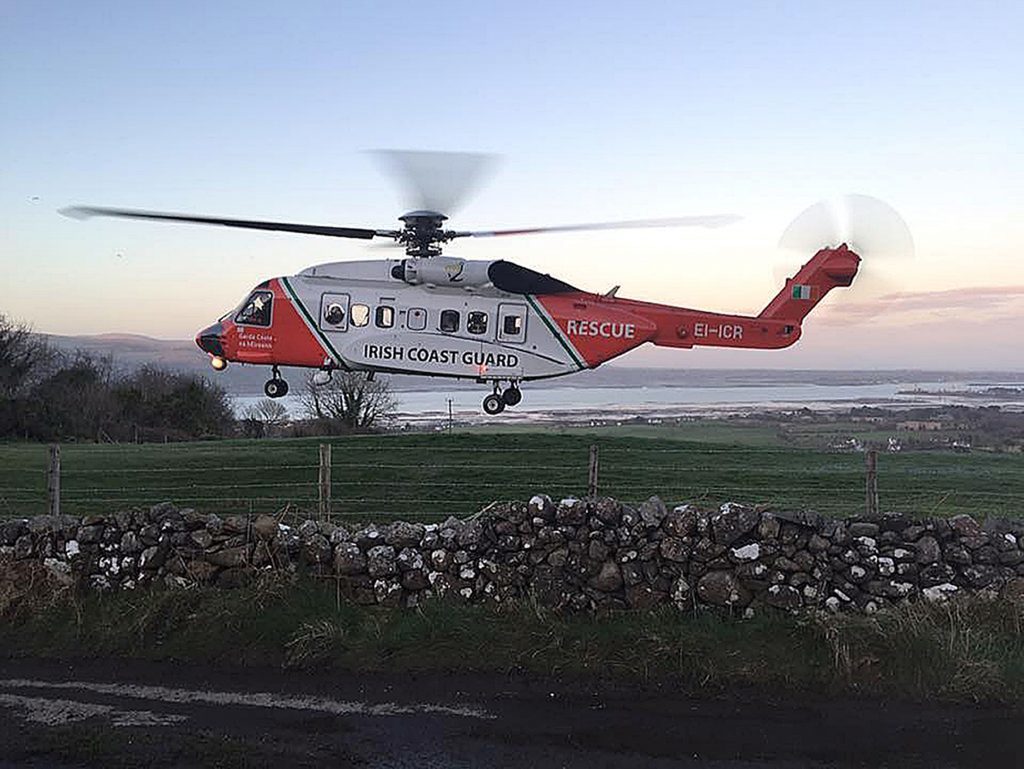
The Sikorsky S92 Irish Coast Guard helicopter that crashed into the Atlantic a week ago struck rocks on an island, investigators have said.
Ahead of a forecasted weather window on Wednesday or Thursday for a seabed search for three crew, the team in charge of trying to determine the cause of the crash said it found wreckage with collision marks.
Ireland’s Air Accident Investigation Unit (AAIU) said it believed the tail of Rescue 116 hit rocks on the western end of Blackrock island, about 13km off the Mayo coast.
AAIU chief inspector Jurgen Whyte and investigator-in-charge Paul Farrell said it was too early to be definitive about what caused the damage on the recovered wreckage, the circumstances of the accident or exactly where it happened.
They said: “However, there appears to be marks on some of the recovered wreckage which are consistent with the tail of the aircraft contacting rocky surfaces on the Western end of Blackrock.
“The Investigation has not yet definitively identified the initial point of impact.”
The Dublin-based helicopter crashed while returning to refuel at Blacksod, Co Mayo, after supporting a rescue mission 240km out in the Atlantic.
The funeral took place on Saturday for Captain Dara Fitzpatrick, the only one of the four crew recovered from the ocean so far.
The 45-year-old mother-of-one was remembered as a hero, an adoring mother and a champion of the underdog, during a packed service at St Patrick’s Church, Glencullen, in the Dublin mountains.
The other crew members – Captain Mark Duffy, Winchman Ciaran Smith and Winch Operator Paul Ormsby – remain missing.
Taoiseach Enda Kenny visited the search mission on Monday and said the families of the crew needed answers as it emerged a submersible vehicle or divers could be sent into the 40m-deep ocean later in the week.
Mr Kenny said: “What we need now to find out here is what happened.
“There are four families involved in this. They need to know, obviously to bring closure to this, but also in respect of the service itself and the facilities that are provided, to find out the actual facts of how this tragedy occurred.”
Blackrock is a small rocky island with a working lighthouse.
There was no indication of any danger moments before the Sikorsky S92 vanished, with the crew’s final transmission: “Shortly landing at Blacksod.”
A 100m by 100m zone of ocean beside the island was scanned over the weekend using sonar to try to find the helicopter in the area where signals from the black box are being detected.
The area was mapped and cleared for the Irish Lights vessel, the Granuaile, to manoeuvre into position alongside the Irish Naval Service ship LE Eithne when a wide enough weather window clears.
Irish Coast Guard spokesman Declan Geoghegan said: “We might get a little window this evening or tomorrow, just for a few hours.
“We’ve been building up a picture of the seabed and surroundings at Blackrock with a view to having the first dive or sending down a remotely operated vehicle (ROV).
“The first opportunity of a break – there might be a window in the next 48 hours – we will move. We are looking at the weather picking up on Wednesday and Thursday.”
The Granuaile is in the area, ready to deploy. It has a heavy-lifting crane as well as dynamic positioning technology, which allows it to remain in the same spot on the surface – much like an aircraft would hover – so divers or remote operated vehicles can be put into the ocean to search 40m below.
The underwater terrain, part of the lighthouse rock and dangerous underwater currents in the area are adding to difficulties.
It could take three hours to have the LE Eithne and Granuaile co-ordinate an ROV launch with the Marine Institute or send down divers, but swells need to be below three metres and currents less than seven knots for divers.
While search teams are confident they are looking in the right area for the black box, they will not know if it remains attached to the missing helicopter fuselage, or if the fuselage remains intact, until divers or underwater vehicles are deployed.
It is hoped the black box recorder – fitted behind the cockpit seats – is still attached to the bulk of the helicopter wreckage, or near it, and that the three missing crewmen will be inside.
Dive teams will also be considering the nature of going down into such deep water – using mixed gas, an umbilical cable air feed or saturated dive.
The AAIU also said its investigation team was being supported by an official from the US National Transportation Safety Board because of where the Sikorsky is designed and built, and has access to advisers from the US Federal Aviation Administration and Sikorsky.